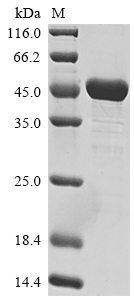Recombinant Human Paired box protein Pax-5 (PAX5) is produced through an E.coli expression system, containing the complete protein sequence spanning amino acids 1 to 391. The protein carries both an N-terminal His-tag and a C-terminal Myc-tag. Purity reaches over 90%, as confirmed by SDS-PAGE analysis, which should provide dependable results across different research applications. This protein product is intended for research use only and has been carefully engineered to support precise experimental work.
Pax-5 appears to be a crucial transcription factor that governs B-cell development and function. It seems to play a vital role during early B-cell lineage commitment and differentiation, likely influencing the expression of genes that define B-cell identity. Given its central position in immune system processes, Pax-5 has become an important target in immunological research, especially in studies examining B-cell pathways and related disorders.
Potential Applications
Note: The applications listed below are based on what we know about this protein's biological functions, published research, and experience from experts in the field. However, we haven't fully tested all of these applications ourselves yet. We'd recommend running some preliminary tests first to make sure they work for your specific research goals.
The human PAX5 is a transcription factor containing a DNA-binding paired domain and requires precise folding for its transcriptional regulatory functions. E. coli lacks the eukaryotic chaperone systems and post-translational modifications that may be important for proper folding of complex eukaryotic transcription factors. The dual-tag system, particularly the large N-terminal 10xHis tag, may sterically interfere with DNA-binding domain functionality. Without experimental validation (e.g., electrophoretic mobility shift assays for DNA binding or functional reporter assays), the protein cannot be assumed to be correctly folded or bioactive.
1. Antibody Development and Validation Studies
This recombinant PAX5 is suitable as an immunogen for antibody production, as antibodies can recognize linear epitopes even in misfolded proteins. The dual tags provide additional epitopes for antibody screening. However, antibodies generated may not recognize native, properly folded PAX5 in nuclear contexts due to conformational differences. Validate antibody specificity against endogenous PAX5 in B-cell nuclei or eukaryotic-expressed PAX5.
2. Protein-Protein Interaction Studies
The tags enable pull-down assays, but if PAX5 is misfolded, interactions may be non-physiological. The DNA-binding domain must be properly folded for authentic interactions with transcriptional partners. Validate any identified interactions using full-length, properly folded PAX5 from eukaryotic systems.
3. ELISA-Based Quantitative Assays
This recombinant PAX5 protein can be used for ELISA development if properly validated. However, if misfolded, it may not accurately reflect native PAX5 antigenicity. The Myc tag facilitates detection, but ensures the protein's conformation matches native PAX5 for quantitative accuracy. Validate with native PAX5 standards.
4. Tag-Assisted Purification Method Development
This application is feasible regardless of folding status. The recombinant PAX5 protein can be used to optimize dual-tag purification protocols, tag removal strategies, and solubility enhancement methods. This use does not require native folding or bioactivity.
Final Recommendation & Action Plan
Before using this recombinant PAX5 for functional studies, validate its folding and DNA-binding capability. Start with electrophoretic mobility shift assays (EMSA) using known PAX5-binding DNA sequences to confirm DNA-binding activity. If active, proceed with interaction or functional studies; if inactive, limit use to non-functional applications like antibody production or purification optimization. For reliable transcriptional studies, consider expressing PAX5 in a eukaryotic system. Always validate outcomes with native PAX5 controls.






